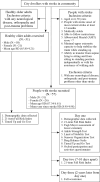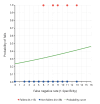Psychometric properties of the Chinese version of 21-item Fall Risk Index for community-dwelling older adults with stroke
- PMID: 40856373
- PMCID: PMC12406963
- DOI: 10.23736/S1973-9087.25.08919-1
Psychometric properties of the Chinese version of 21-item Fall Risk Index for community-dwelling older adults with stroke
Abstract
Background: The 21-item Fall Risk Index questionnaire (FRI-21) was developed to screen for fall risk in older adults. It showed great potential in assessing the fall risk in stroke population. However, no previous study investigated its reliability and validity in people with stroke in Hong Kong.
Aim: This study aimed to translate FRI-21 to Chinese and investigate: 1) the FRI-21 scores between people with stroke and healthy older adults; 2) the test-retest reliability of the FRI-21 in people with stroke; 3) the convergent validity by correlated of the FRI-21 with Berg Balance Scale (BBS); 4) the predictive ability of FRI-21 on the fall occurrence in the 2 years follow-up; 5) the optimal FRI-21 cut-off score that distinguishes faller and non-faller among people with stroke in the 2 years follow-up; and 6) the ceiling and floor effects of the Chinese version of the FRI-21.
Design: Cross-sectional study.
Setting: University-based rehabilitation laboratory.
Population: In total, 57 people with stroke and 31 healthy older adults.
Methods: The FRI-21 test was assessed in people with stroke on Day1 and Day 2 (7 days after Day 1), and assessed in healthy older adults on Day 1 only. The BBS was also assessed in Day 1.
Results: The mean FRI-21 scores in subjects with stroke was 7.37. The FRI-21 demonstrated good inter-rater reliability (intraclass correlation [ICC] 0.74) and good test-retest reliability (ICC=0.798) in people with stroke. The FRI-21 scores demonstrated significant negative correlations with the BBS (r=-0.308). The FRI-21 score was found to be a significant predictor (OR 1.40 [95% CI 1.06-1.85], P=0.018) of fall in the 2 years of follow-up. The receiver operating characteristic curve analysis identified an optimal FRI-21 cutoff score of 7.5, showing an acceptable diagnostic power in distinguishing faller and non-faller among people with stroke (area under curve = 0.723, P=0.002), with moderate sensitivity (80.0%) and specificity (60.5%). Ceiling and floor effects are negligible.
Conclusions: This study reflects the reliability and validity of the FRI-21 as self-administered tool for assessing fall risk in individuals aged 50 and over with stroke, and without cognitive impairments. A cut-off score of 7.5 was identified to distinguish faller and non-faller in people with stroke. The FRI-21 score was a significant predictor of fall in people with stroke. It effectively differentiates fall risk between people with stroke and healthy older adults. Future research should increase the sample size to enhance the generalizability of the findings.
Clinical rehabilitation impact: Clinicians can use this tool to efficiently identify high-risk individuals among stroke survivors and implement targeted early interventions. This early fall risk screening tool allows healthcare providers to initiate preventive measures and intensive rehabilitation protocols for those at greatest risk, potentially reducing secondary complications, improving functional outcomes, and decreasing hospital readmission rates.
Conflict of interest statement
Figures
References
-
- Schmid AA, Yaggi HK, Burrus N, McClain V, Austin C, Ferguson J, et al. Circumstances and consequences of falls among people with chronic stroke. J Rehabil Res Dev 2013;50:1277–86. https://www.ncbi.nlm.nih.gov/entrez/query.fcgi?cmd=Retrieve&db=PubMed&l... 10.1682/JRRD.2012.11.0215 - DOI - PubMed
-
- Vieira ER, Palmer RC, Chaves PH. Prevention of falls in older people living in the community. BMJ 2016;353:i1419–i. https://www.ncbi.nlm.nih.gov/entrez/query.fcgi?cmd=Retrieve&db=PubMed&l... 10.1136/bmj.i1419 - DOI - PubMed
-
- Chan K, Fong K. Accidental falls among community-dwelling people with chronic stroke in Hong Kong. Asian J Gerontol Geriatr 2013;8:61–7.
-
- Fong KN, Siu AM, Yeung KA, Cheung SW, Chan CC. Falls among the community-living elderly people in Hong Kong: a retrospective study. Hong Kong J Occup Ther 2011;21:33–40. 10.1016/j.hkjot.2011.05.005 - DOI
-
- Toba K, Kikuchi R, Iwata A, Kozaki K. Fall risk index helps clinicians identify high-risk individuals. Japan Med Assoc J 2009;52:237–42.
MeSH terms
LinkOut - more resources
Full Text Sources
Medical




